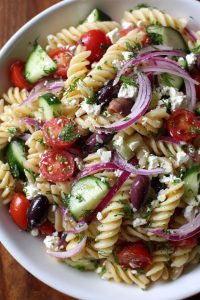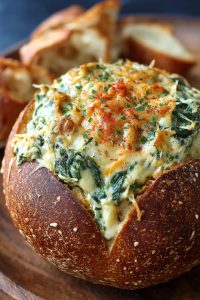Unlocking the vibrant essence of coastal Mediterranean cuisine, this pasta salad transforms humble ingredients into an extraordinary culinary experience. Utilizing precise techniques and balanced flavor profiles, this dish showcases how professional methodology elevates everyday components into restaurant-quality fare. Understanding the interplay between textures and acidity creates a harmonious composition that stands up to refrigeration while maintaining structural integrity.
Why This Recipe Works
- The strategic use of pasta cooking water creates an emulsified vinaigrette that clings perfectly to every surface, ensuring even flavor distribution throughout the salad without compromising texture integrity.
- Layering ingredients at specific temperature stages prevents wilting of delicate herbs and vegetables while allowing robust flavors to meld properly during the resting period.
- Employing the shock-and-spread technique for cooling pasta ensures optimal starch retention for sauce adhesion while preventing overcooking that would lead to mushy textures.
- Balancing acidic components with quality olive oil creates a bright yet rounded flavor profile that doesn’t overwhelm the palate, allowing individual ingredients to shine through.
- Strategic salting at multiple stages—pasta water, vegetable preparation, and final seasoning—builds depth of flavor that cannot be achieved through single-stage seasoning alone.
Ingredients
- 1 pound fusilli pasta
- 2 tablespoons kosher salt for pasta water
- 1 English cucumber, small dice
- 2 cups cherry tomatoes, halved
- 1 red onion, finely julienned
- 1 cup Kalamata olives, pitted and halved
- 8 ounces feta cheese, crumbled
- 1/2 cup fresh parsley, finely chopped
- 1/4 cup fresh mint, chiffonade
- 1/4 cup fresh dill, finely minced
- 1/2 cup extra virgin olive oil
- 1/4 cup red wine vinegar
- 2 tablespoons lemon juice, freshly squeezed
- 2 garlic cloves, microplaned
- 1 teaspoon dried oregano
- 1/2 teaspoon black pepper, freshly ground
- 1/4 teaspoon red pepper flakes
Equipment Needed
- Large stockpot (8-quart minimum)
- Spider strainer or colander
- Rimmed baking sheet
- Microplane grater
- Chef’s knife
- Cutting board
- Large mixing bowls (2)
- Whisk
- Measuring cups and spoons
- Kitchen timer
Instructions

Pasta Preparation and Emulsification Base
Begin by bringing 6 quarts of water to a rolling boil in your stockpot, adding 2 tablespoons of kosher salt once boiling—the water should taste distinctly salty, like seawater. Add fusilli pasta and cook for exactly 8 minutes, stirring occasionally to prevent sticking, until al dente with a firm bite. While pasta cooks, combine 1/2 cup extra virgin olive oil, 1/4 cup red wine vinegar, 2 tablespoons lemon juice, microplaned garlic cloves, dried oregano, black pepper, and red pepper flakes in a large mixing bowl, whisking vigorously until fully emulsified. Reserve 1/2 cup of starchy pasta water before draining, then immediately spread hot pasta across a rimmed baking sheet in a single layer to cool rapidly, which prevents overcooking while maintaining ideal starch coating for sauce adhesion.
Vegetable Preparation and Flavor Layering
While pasta cools to room temperature, approximately 15-20 minutes, prepare all vegetables using precise knife cuts to ensure consistent texture and optimal flavor release. Cut English cucumber into 1/4-inch dice, creating uniform pieces that provide refreshing crunch without overwhelming the palate. Halve cherry tomatoes through the stem end to maintain structural integrity, then place in a separate bowl and sprinkle lightly with salt to draw out excess moisture. Julienne red onion into thin matchsticks using a sharp chef’s knife, then soak in ice water for 10 minutes to mellow the pungent flavor while maintaining crisp texture. Pit and halve Kalamata olives, ensuring each piece showcases the characteristic briny flavor profile that defines Mediterranean cuisine.
Herb Integration and Cheese Application
Meticulously prepare fresh herbs using proper cutting techniques to preserve essential oils and prevent bruising. Finely chop flat-leaf parsley, removing tough stems while retaining the vibrant green leaves. Create mint chiffonade by stacking leaves, rolling tightly, then slicing perpendicular to create delicate ribbons that release maximum aroma. Finely mince dill fronds, avoiding the woody stems, to distribute their distinctive anise-like flavor evenly throughout the salad. Crumble feta cheese by hand into irregular chunks rather than uniform cubes, creating varied texture pockets that deliver creamy bursts of salty tang against the other components.
Assembly and Initial Resting Period
Combine cooled pasta with the emulsified vinaigrette in your largest mixing bowl, tossing thoroughly to coat every surface. Add 2 tablespoons of reserved pasta water to loosen the dressing and help it cling to the pasta’s ridges. Incorporate prepared vegetables—cucumber, tomatoes (drained of excess liquid), red onion (drained and patted dry), and olives—gently folding to distribute evenly without crushing delicate components. Add half of the herb mixture, reserving the remainder for garnish, and fold carefully to maintain herb integrity. Cover bowl with plastic wrap and refrigerate for exactly 30 minutes to allow flavors to meld while maintaining crisp vegetable textures.
Final Seasoning and Service Preparation
Remove salad from refrigeration and taste for seasoning, adjusting with additional salt, pepper, or lemon juice as needed. The flavors will have developed and concentrated during the resting period, requiring careful recalibration. Gently fold in crumbled feta cheese and remaining fresh herbs, taking care not to overmix and break down the cheese chunks. Transfer to serving platter, creating an attractive presentation with height and visual appeal. Allow to stand at room temperature for 10 minutes before serving to take the chill off and maximize flavor perception. The finished salad should showcase distinct components while delivering harmonious Mediterranean flavors in every bite.
Tips and Tricks
For optimal texture maintenance, consider salting tomatoes separately and draining excess liquid before incorporation—this prevents the salad from becoming watery during storage. When working with fresh herbs, always add them in two stages: half during initial assembly for flavor infusion, and the remainder just before serving to maintain vibrant color and aromatic presence. For enhanced flavor development, prepare the vinaigrette up to 24 hours in advance, allowing the garlic and dried oregano to fully hydrate and meld with the acidic components. When selecting pasta shape, fusilli’s spiral structure provides excellent sauce adhesion, but farfalle or rotini also work well due to their textured surfaces and ability to hold dressings effectively. For professional presentation, use a slotted spoon to transfer the salad to serving dishes, leaving excess dressing behind to prevent pooling at the bottom. If making ahead, store components separately and combine no more than 2 hours before service, with the exception of the dressed pasta which can be prepared up to 8 hours in advance. To elevate the dish further, consider toasting the dried oregano in a dry skillet for 30 seconds before adding to the vinaigrette, which releases essential oils and deepens the flavor profile. When measuring olive oil, use liquid measuring cups for accuracy, as the difference between 1/2 cup and 2/3 cup can significantly impact the dressing’s balance. For food safety, never leave the completed salad at room temperature for more than 2 hours, and always use clean, dry utensils when serving to prevent contamination and maintain freshness throughout multiple servings.
Recipe Variations
- Protein Enhancement: Incorporate 2 cups of grilled chicken thigh meat, sliced against the grain into 1/4-inch pieces, or 1 pound of peeled, deveined shrimp sautéed with garlic and lemon zest. For vegetarian protein, add 2 cups of chickpeas roasted with cumin and smoked paprika until crispy, or 8 ounces of marinated tofu cubes pan-seared until golden brown. These additions transform the salad into a complete meal while maintaining Mediterranean flavor profiles.
- Grain Substitutions: Replace pasta with 4 cups of cooked farro, quinoa, or couscous for alternative texture experiences. Farro provides chewy nuttiness, quinoa offers delicate fluffiness, and couscous delivers light, quick-cooking convenience. Adjust dressing quantities accordingly, as different grains absorb liquids at varying rates, and consider toasting grains before cooking to enhance their inherent flavors and improve structural integrity in the finished dish.
- Regional Twists: For Greek inspiration, add 1 cup of marinated artichoke hearts and substitute basil for mint, with a final drizzle of high-quality Greek olive oil. For Italian influence, incorporate 1/2 cup of sun-dried tomatoes and roasted red peppers, using aged balsamic vinegar instead of red wine vinegar. Middle Eastern variations might include sumac in the dressing and pomegranate seeds for garnish, creating bright, tart counterpoints to the rich components.
- Seasonal Adaptations: Summer versions can highlight heirloom tomatoes and fresh corn, while autumn iterations might include roasted squash and toasted pumpkin seeds. Winter adaptations could feature roasted root vegetables and preserved lemons, with spring variations showcasing fresh peas and asparagus tips. Each seasonal adjustment maintains the core Mediterranean principles while highlighting the best available produce for maximum flavor impact and visual appeal.
Frequently Asked Questions
Can I make this pasta salad ahead of time for meal prep?
Yes, this salad excels when prepared in advance, but requires strategic component management. Cook and dress the pasta up to 24 hours ahead, storing separately from raw vegetables in airtight containers. Combine all elements no more than 4-6 hours before serving to maintain optimal texture integrity. The dressed pasta actually benefits from overnight marination as the flavors penetrate more deeply, but delicate vegetables like cucumbers and herbs should be added closer to service. For best results, store at consistent refrigerator temperatures and bring to room temperature for 15 minutes before final assembly and serving.
What’s the best way to prevent the pasta salad from becoming dry?
The key to maintaining proper moisture lies in the reserved pasta water technique and proper emulsification. Always save at least 1/2 cup of starchy cooking liquid, adding 2 tablespoons during initial dressing and more as needed during final seasoning. The starch molecules in the pasta water help the oil and vinegar emulsion cling to the pasta surfaces rather than pooling at the bottom. Additionally, ensure your vinaigrette is properly balanced with adequate olive oil, which coats each ingredient and creates a protective barrier against moisture loss during refrigeration.
How long will Mediterranean pasta salad keep in the refrigerator?
When stored properly in an airtight container, this salad maintains excellent quality for 3-4 days. The high acidity from vinegar and lemon juice acts as a natural preservative, while the olive oil coating helps prevent oxidation. Texture will gradually soften over time, with vegetables losing some crispness after 48 hours. For extended storage, consider keeping dressing separate and combining just before serving. Always use clean utensils when removing portions to prevent contamination, and discard if any signs of spoilage appear, such as off odors or visible mold growth.
Can I substitute different types of pasta in this recipe?
Absolutely, though shape selection significantly impacts the final result. Short pasta with ridges or cavities work best—farfalle, rotini, penne, or orecchiette all provide excellent sauce adhesion and textural interest. Avoid long strands like spaghetti or linguine, which become difficult to eat as a salad. Whole wheat or gluten-free alternatives work well but may require adjusted cooking times and additional dressing due to different absorption rates. Regardless of shape, always cook to al dente perfection and cool properly to maintain structural integrity throughout the marinating process.
What’s the secret to getting restaurant-quality flavor in homemade pasta salad?
The professional approach involves three critical elements: proper seasoning at multiple stages, strategic ingredient timing, and attention to textural contrasts. Season your pasta water aggressively, salt vegetables separately to draw out flavors, and always taste and adjust seasoning after the resting period. Add ingredients at their optimal temperature stages—hot pasta absorbs dressing better, while cold vegetables maintain crunch. Create textural interest through varied cutting techniques and careful component distribution rather than uniform chopping. Finally, use high-quality ingredients, particularly extra virgin olive oil and fresh herbs, which provide the flavor foundation that cannot be replicated with inferior products.
Summary
This Mediterranean pasta salad exemplifies professional technique through strategic ingredient timing, proper emulsification, and balanced flavor development. The method transforms simple components into an extraordinary dish that maintains structural integrity while delivering complex, harmonious Mediterranean flavors in every perfectly seasoned bite.



